Have you ever come across slash chords when learning the chords of a song but weren’t sure what they meant? These symbols are quite simpler to understand than you might think.
In this lesson, we cover what slash chords are, how and why they’re used on guitar, and also give you musical examples that you can use to incorporate to your playing.
Let’s get started!
What is a slash chord?
Slash chords represent a chord with a specific bass note. The note to the left of the slash indicates the chord and the note to the right of the slash indicates which bass note to play.
For example, G/B (G over B) means you play a G chord which includes the notes G, B, and D, but the B note be would in the bass, the lowest note in your chord.
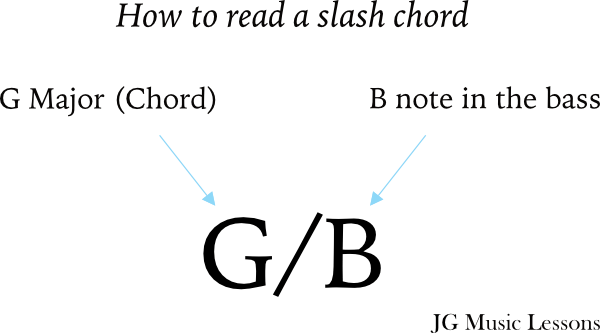
Now, I’ll show you how to play this slash chord on the guitar. The notes to the right of the chord charts below tell you the specific notes being played on each string. Compare the open G Major chord with a G/B chord below.
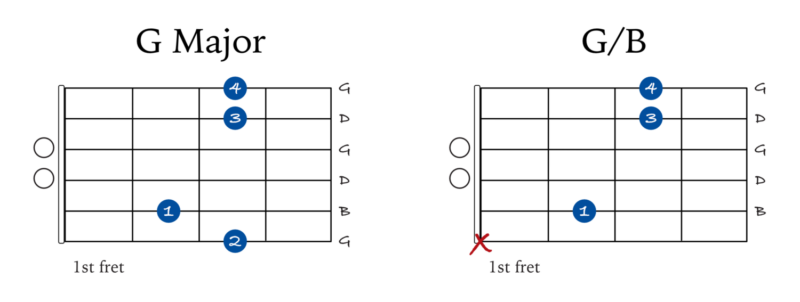
This is kind of chord is called an inversion which means to use a chord tone other than the root of the chord as the bass note. See this lesson on triads if you need help understanding this.
However, not all slash chords are inversions (more on this later in the lesson).
See the charts below to show you what I mean. The notes to the right of the chord charts tell you the specific notes being played on each string.
Examples of slash chords on guitar
Here are some examples of slash chords on the guitar in first position. These are all variations of some of the first chords you should know on guitar.

You can also check out how to play chord inversions on guitar to learn movable inverted chord shapes.
Why use slash chords?
Slash chords can function in different ways such as for passing chords, simplifying chord names, and create chord pedals. If some terms seem unfamiliar, don’t worry, we’ll look at different examples so you can have a better understanding of these concepts work.
What’s the difference between a bass note and a root note?
The difference between a bass note and root note is that a bass note is the lowest note in a chord which can include any scale degree while the root note is the first scale degree from which a chord is built on.
For example, C/E means you play a C Major chord but E is the bass note. However, the root note is C, which is the 1st degree of the C Major triad which includes the notes C, E, and G.
Slash chords as passing chords
Slash chords can act as ‘passing chords’ meaning they create smooth transitions to connect a series of chords because the bass notes can be changed. When slash chords are used as passing chords, they are most likely an inversion of a chord.
This next example shows how a slash chord acts as a passing chord to create a smoother transition.
For example, instead of playing this progression: C, G, A min and, G, you can play:

Notice that when using the G/B chord, the bass line now moves in a scale like manner going down: C, B, A, G.
Try playing this example and notice how the slash chord changes the feel of the progression compared to the original chords.
Here is another example. Instead of playing G, D, E minor, and D in a progression, you can play the second chord as an inversion like this:
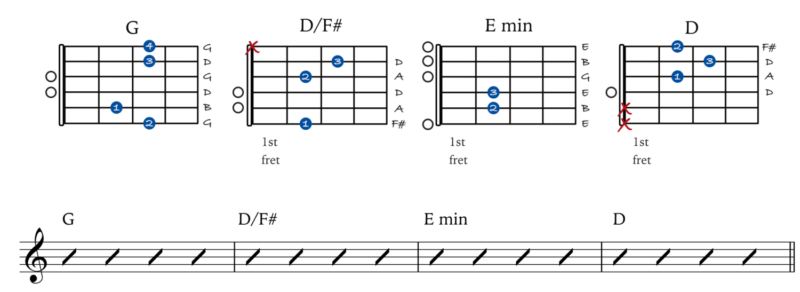

Using slash chords to simplify chord names
Whenever you have a chord that includes notes other than the original triad or 7th chords which also include chord extensions, the slash chord can simplify what notes belong to the chord.
For example, you can have a C chord which includes the triad notes C, E, and G. But as I mentioned before, with slash chords, you can add a completely different bass note to change the function of the chord.
For example, if you write C/D, now you are implying a very different chord which includes C, E, G, and D in the bass. This could be a simplification of a more complex chord like D7 (9) sus4 or D min (11, 9).
This C/D chord can be played as follows:
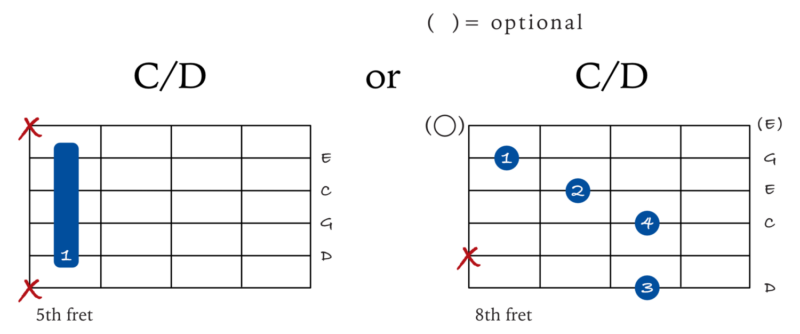
Here’s another example, instead of writing G Maj7 (9) which implies the notes G, B, D, F#, and A you can simply write D/G to imply the same chord.
Since you can’t always include all the notes in an extended chord anyways, slash chords can provide good alternatives for the same chord. Of course, you have to look at chords in context to see how they are functioning in a chord progression but generally, slash chords can make chord notation much simpler.
Notice how the notes in the following charts are the same but the chord is simplified by using the slash chord notation.
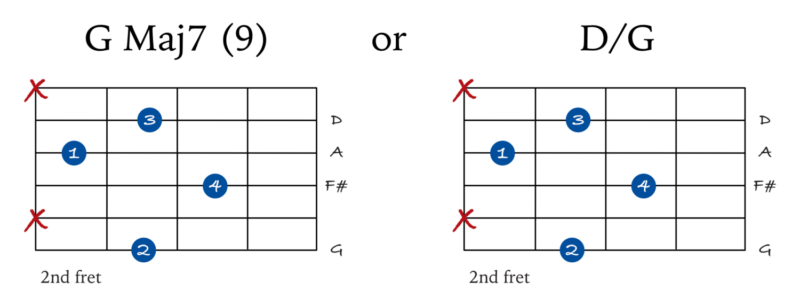
Again, the context of chords is important but you can see this how works to make this simpler and concise.
Using slash chords as chord pedals
Another way that slash chords are used is to create chord pedals. A chord pedal is when a series of chords are changing but the bass note remains the same.
For example:
Instead of these chords:
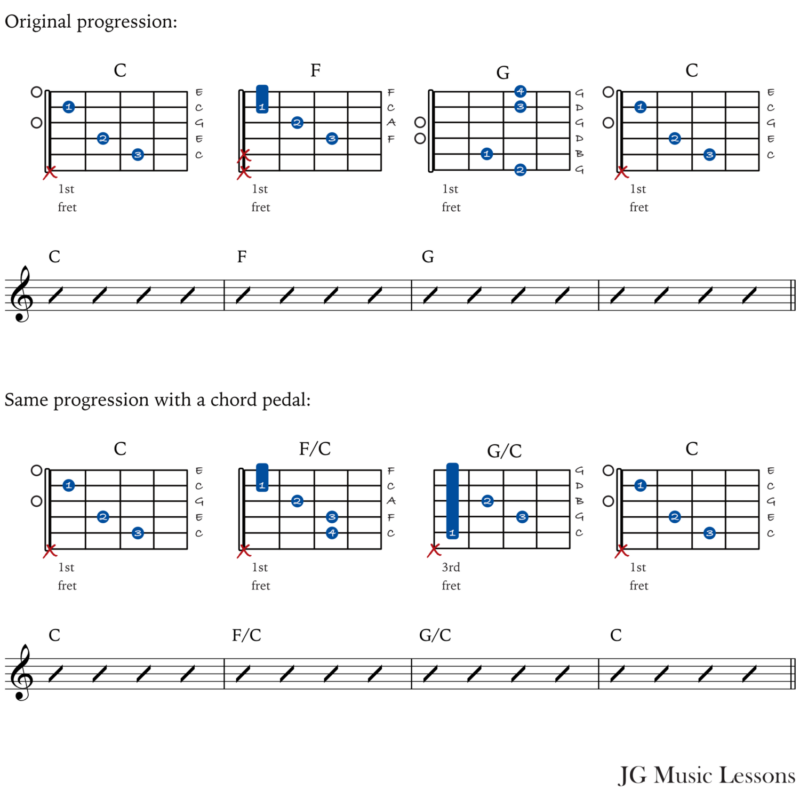
This is a tool you can use from time to time to give a different feel to a section of a song or progression.
The chords in the previous progression are all related chords within the key of C but we can also play a progression using non-diatonic chords, meaning chords that are unrelated to the original key and still keep the same bass note to create a cool effect.
This is a more advanced technique when you borrow from different keys in a chord progression, also called borrowed chords or modal interchange.
Here is an example of a chord progression using borrowed chords:
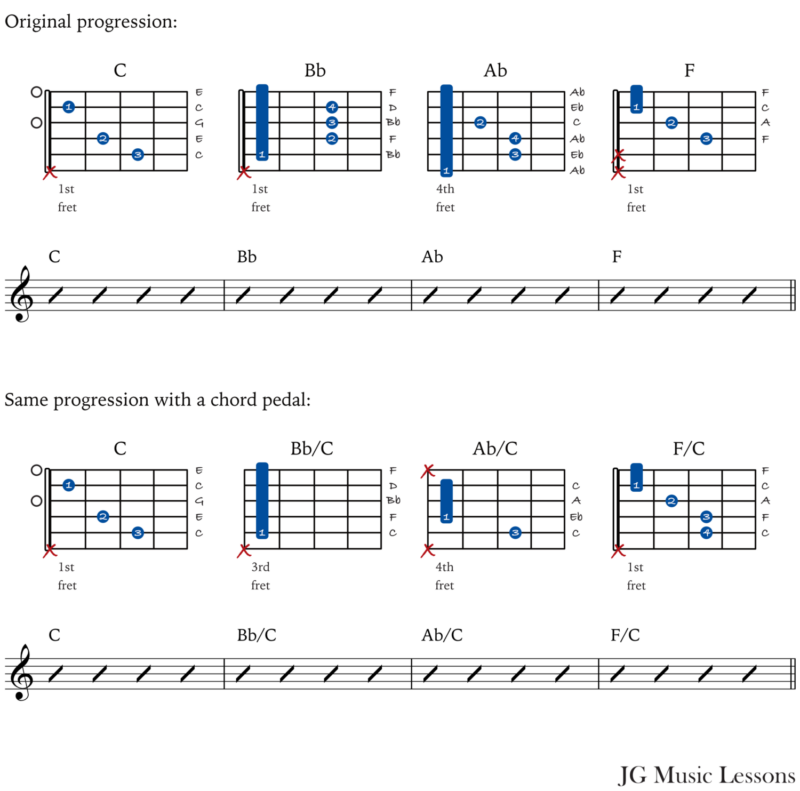
Although these chords are not related within the same diatonic scale, keeping the same bass notes glues the series of chords together. Using these slash chords to create the chord pedal doesn’t necessarily mean it sounds better, it simply creates a different musical effect that you can use to enhance or vary a chord progression.
Tip for slash chords
If you are playing along with others instruments, the bassist or pianist will likely play the bass note of a slash chord since they have lower ranges of notes on their instruments than a guitar. If this is the case, you can simply play the chord that is stated to the left of the slash.
Regardless, it’s still good to know how to do this on your instrument if you were to play something on your own so you can maximize the sound of your chords.
Wrapping up
As we covered in this lesson, slash chords are a way to notate chords with a specific bass note. We looked at how they can act as passing chords, how they help to simplify chord names, and finally how they can be used to create chord pedals when keeping the same bass note.
I hope this lesson gave you a better understanding of how slash chords work and how you can begin to use them in your playing. Enjoy and keep learning!
📘 Get the free guitar practice guide here!
All the best,
JG
Start Playing Better, Faster
with Pro Membership! ✨
Get the guidance, tools, and support that keep your progress on track:
🏁 Always know what to practice next. Access the full Guitar Learning Roadmap with lessons in sequence.
🎼 Play songs with confidence. Step-by-step lessons of popular, classical pieces and other styles.
📙 Save time and frustration. Clear PDFs and ebooks that save time so you can focus on playing.
🎟️ Get rewarded for consistency. 2 free downloads every month (a $240+ yearly value).
🎁 Keep costs low while you grow. 50% off all charts, tracks, and posters — up to 75% off bundles.
🚫 Stay focused. Ad-free environment keeps you in the zone.
💬 Get help when you need it. Direct member support to keep you on track.

